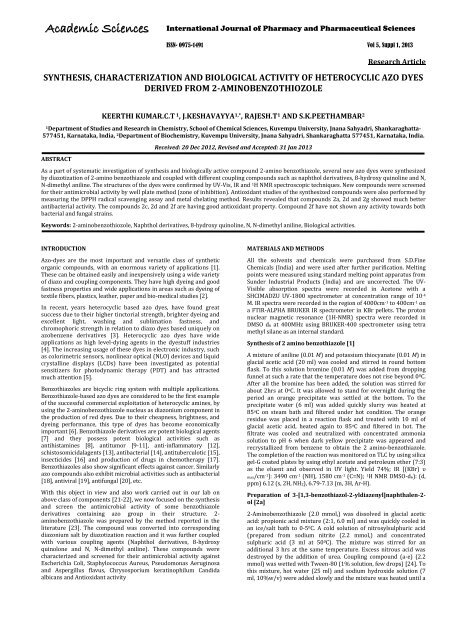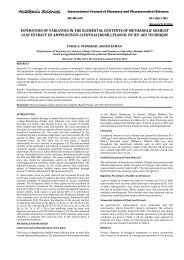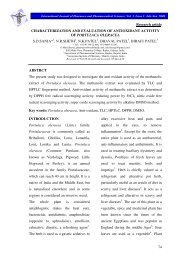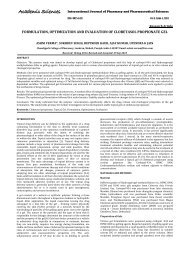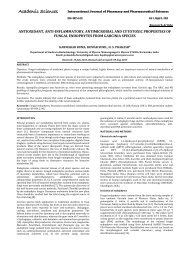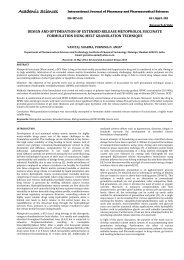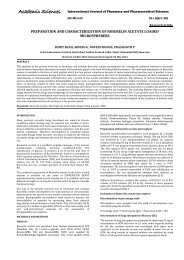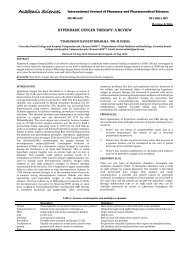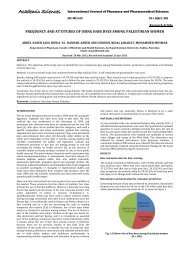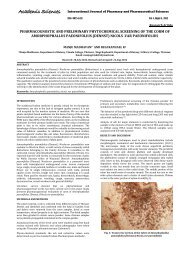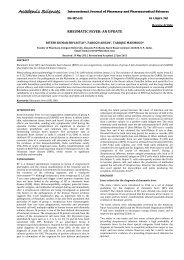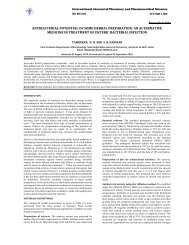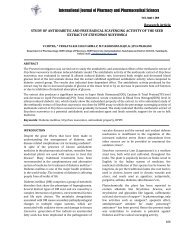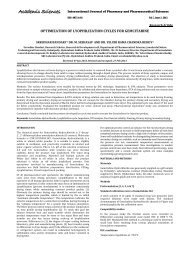synthesis, characterization and biological activity of heterocyclic azo
synthesis, characterization and biological activity of heterocyclic azo
synthesis, characterization and biological activity of heterocyclic azo
You also want an ePaper? Increase the reach of your titles
YUMPU automatically turns print PDFs into web optimized ePapers that Google loves.
Academic Sciences<br />
Research Article<br />
SYNTHESIS, CHARACTERIZATION AND BIOLOGICAL ACTIVITY OF HETEROCYCLIC AZO DYES<br />
DERIVED FROM 2-AMINOBENZOTHIOZOLE<br />
KEERTHI KUMAR.C.T 1 , J.KESHAVAYYA 1,* , RAJESH.T 1 AND S.K.PEETHAMBAR 2<br />
1 Department <strong>of</strong> Studies <strong>and</strong> Research in Chemistry, School <strong>of</strong> Chemical Sciences, Kuvempu University, Jnana Sahyadri, Shankaraghatta-<br />
577451, Karnataka, India, 2 Department <strong>of</strong> Biochemistry, Kuvempu University, Jnana Sahyadri, Shankaraghatta 577451, Karnataka, India.<br />
ABSTRACT<br />
Received: 20 Dec 2012, Revised <strong>and</strong> Accepted: 31 Jan 2013<br />
As a part <strong>of</strong> systematic investigation <strong>of</strong> <strong>synthesis</strong> <strong>and</strong> <strong>biological</strong>ly active compound 2-amino benzothi<strong>azo</strong>le, several new <strong>azo</strong> dyes were synthesized<br />
by di<strong>azo</strong>tization <strong>of</strong> 2-amino benzothi<strong>azo</strong>le <strong>and</strong> coupled with different coupling compounds such as naphthol derivatives, 8-hydroxy quinoline <strong>and</strong> N,<br />
N-dimethyl aniline. The structures <strong>of</strong> the dyes were confirmed by UV-Vis, IR <strong>and</strong> 1 H NMR spectroscopic techniques. New compounds were screened<br />
for their antimicrobial <strong>activity</strong> by well plate method (zone <strong>of</strong> inhibition). Antioxidant studies <strong>of</strong> the synthesized compounds were also performed by<br />
measuring the DPPH radical scavenging assay <strong>and</strong> metal chelating method. Results revealed that compounds 2a, 2d <strong>and</strong> 2g showed much better<br />
antibacterial <strong>activity</strong>. The compounds 2c, 2d <strong>and</strong> 2f are having good antioxidant property. Compound 2f have not shown any <strong>activity</strong> towards both<br />
bacterial <strong>and</strong> fungal strains.<br />
Keywords: 2-aminobenzothiozole, Naphthol derivatives, 8-hydroxy quinoline, N, N-dimethyl aniline, Biological activities.<br />
INTRODUCTION<br />
Azo-dyes are the most important <strong>and</strong> versatile class <strong>of</strong> synthetic<br />
organic compounds, with an enormous variety <strong>of</strong> applications [1].<br />
These can be obtained easily <strong>and</strong> inexpensively using a wide variety<br />
<strong>of</strong> di<strong>azo</strong> <strong>and</strong> coupling components. They have high dyeing <strong>and</strong> good<br />
fastness properties <strong>and</strong> wide applications in areas such as dyeing <strong>of</strong><br />
textile fibers, plastics, leather, paper <strong>and</strong> bio-medical studies [2].<br />
In recent, years <strong>heterocyclic</strong> based <strong>azo</strong> dyes, have found great<br />
success due to their higher tinctorial strength, brighter dyeing <strong>and</strong><br />
excellent light, washing <strong>and</strong> sublimation fastness, <strong>and</strong><br />
chromophoric strength in relation to di<strong>azo</strong> dyes based uniquely on<br />
<strong>azo</strong>benzene derivatives [3]. Heterocyclic <strong>azo</strong> dyes have wide<br />
applications as high level-dying agents in the dyestuff industries<br />
[4]. The increasing usage <strong>of</strong> these dyes in electronic industry, such<br />
as colorimetric sensors, nonlinear optical (NLO) devices <strong>and</strong> liquid<br />
crystalline displays (LCDs) have been investigated as potential<br />
sensitizers for photodynamic therapy (PDT) <strong>and</strong> has attracted<br />
much attention [5].<br />
Benzothi<strong>azo</strong>les are bicyclic ring system with multiple applications.<br />
Benzothi<strong>azo</strong>le-based <strong>azo</strong> dyes are considered to be the first example<br />
<strong>of</strong> the successful commercial exploitation <strong>of</strong> <strong>heterocyclic</strong> amines, by<br />
using the 2-aminobenzothi<strong>azo</strong>le nucleus as di<strong>azo</strong>nium component in<br />
the production <strong>of</strong> red dyes. Due to their cheapness, brightness, <strong>and</strong><br />
dyeing performance, this type <strong>of</strong> dyes has become economically<br />
important [6]. Benzothi<strong>azo</strong>le derivatives are potent <strong>biological</strong> agents<br />
[7] <strong>and</strong> they possess potent <strong>biological</strong> activities such as<br />
antihistamines [8], antitumor [9-11], anti-inflammatory [12],<br />
schistosomicidalagents [13], antibacterial [14], antituberculotic [15],<br />
insecticides [16] <strong>and</strong> production <strong>of</strong> drugs in chemotherapy [17].<br />
Benzothi<strong>azo</strong>les also show significant effects against cancer. Similarly<br />
<strong>azo</strong> compounds also exhibit microbial activities such as antibacterial<br />
[18], antiviral [19], antifungal [20], etc.<br />
With this object in view <strong>and</strong> also work carried out in our lab on<br />
above class <strong>of</strong> components [21-22], we now focused on the <strong>synthesis</strong><br />
<strong>and</strong> screen the antimicrobial <strong>activity</strong> <strong>of</strong> some benzothi<strong>azo</strong>le<br />
derivatives containing <strong>azo</strong> group in their structure. 2aminobenzothi<strong>azo</strong>le<br />
was prepared by the method reported in the<br />
literature [23]. The compound was converted into corresponding<br />
di<strong>azo</strong>nium salt by di<strong>azo</strong>tization reaction <strong>and</strong> it was further coupled<br />
with various coupling agents (Naphthol derivatives, 8-hydroxy<br />
quinolone <strong>and</strong> N, N-dimethyl aniline). These compounds were<br />
characterized <strong>and</strong> screened for their antimicrobial <strong>activity</strong> against<br />
Escherichia Coli, Staphylococcus Aureus, Pseudomonas Aeruginosa<br />
<strong>and</strong> Aspergillus flavus, Chrysosporium keratinophilum C<strong>and</strong>ida<br />
albicans <strong>and</strong> Antioxidant <strong>activity</strong><br />
International Journal <strong>of</strong> Pharmacy <strong>and</strong> Pharmaceutical Sciences<br />
ISSN- 0975-1491 Vol 5, Suppl 1, 2013<br />
MATERIALS AND METHODS<br />
All the solvents <strong>and</strong> chemicals were purchased from S.D.Fine<br />
Chemicals (India) <strong>and</strong> were used after further purification. Melting<br />
points were measured using st<strong>and</strong>ard melting point apparatus from<br />
Sunder Industrial Products (India) <strong>and</strong> are uncorrected. The UV-<br />
Visible absorption spectra were recorded in Acetone with a<br />
SHCIMADZU UV-1800 spectrometer at concentration range <strong>of</strong> 10 -4<br />
M. IR spectra were recorded in the region <strong>of</strong> 4000cm -1 to 400cm -1 on<br />
a FTIR-ALPHA BRUKER IR spectrometer in KBr pellets. The proton<br />
nuclear magnetic resonance (1H-NMR) spectra were recorded in<br />
DMSO d6 at 400MHz using BRUKER-400 spectrometer using tetra<br />
methyl silane as an internal st<strong>and</strong>ard.<br />
Synthesis <strong>of</strong> 2 amino benzothi<strong>azo</strong>le [1]<br />
A mixture <strong>of</strong> aniline (0.01 M) <strong>and</strong> potassium thiocyanate (0.01 M) in<br />
glacial acetic acid (20 ml) was cooled <strong>and</strong> stirred in round bottom<br />
flask. To this solution bromine (0.01 M) was added from dropping<br />
funnel at such a rate that the temperature does not rise beyond 0 0 C.<br />
After all the bromine has been added, the solution was stirred for<br />
about 2hrs at 0 o C. It was allowed to st<strong>and</strong> for overnight during the<br />
period an orange precipitate was settled at the bottom. To the<br />
precipitate water (6 ml) was added quickly slurry was heated at<br />
85 o C on steam bath <strong>and</strong> filtered under hot condition. The orange<br />
residue was placed in a reaction flask <strong>and</strong> treated with 10 ml <strong>of</strong><br />
glacial acetic acid, heated again to 85 o C <strong>and</strong> filtered in hot. The<br />
filtrate was cooled <strong>and</strong> neutralized with concentrated ammonia<br />
solution to pH 6 when dark yellow precipitate was appeared <strong>and</strong><br />
recrystallized from benzene to obtain the 2 amino-benzothi<strong>azo</strong>le.<br />
The completion <strong>of</strong> the reaction was monitored on TLC by using silica<br />
gel-G coated plates by using ethyl acetate <strong>and</strong> petroleum ether (7:3)<br />
as the eluent <strong>and</strong> observed in UV light. Yield 74%; IR [(KBr) υ<br />
max/cm -1 ]: 3490 cm -1 (NH), 1580 cm -1 (C=N); 1 H NMR DMSO-d6): (d,<br />
ppm) 6.12 (s, 2H, NH2), 6.79-7.13 (m, 3H, Ar-H).<br />
Preparation <strong>of</strong> 3-[1,3-benzothi<strong>azo</strong>l-2-yldiazenyl]naphthalen-2ol<br />
[2a]<br />
2-Aminobenzothi<strong>azo</strong>le (2.0 mmol,) was dissolved in glacial acetic<br />
acid: propionic acid mixture (2:1, 6.0 ml) <strong>and</strong> was quickly cooled in<br />
an ice/salt bath to 0-5 0 C. A cold solution <strong>of</strong> nitrosylsulphuric acid<br />
(prepared from sodium nitrite (2.2 mmol,) <strong>and</strong> concentrated<br />
sulphuric acid (3 ml at 50 0 C). The mixture was stirred for an<br />
additional 3 hrs at the same temperature. Excess nitrous acid was<br />
destroyed by the addition <strong>of</strong> urea. Coupling compound (a-e) (2.2<br />
mmol) was wetted with Tween-80 (1% solution, few drops) [24]. To<br />
this mixture, hot water (25 ml) <strong>and</strong> sodium hydroxide solution (7<br />
ml, 10%w/v) were added slowly <strong>and</strong> the mixture was heated until a
clear solution was obtained. The solution was cooled to 0–5 ºC in an<br />
ice bath. Freshly prepared di<strong>azo</strong> liquor was added to this solution<br />
drop by drop, over a period <strong>of</strong> an hour keeping the temperature<br />
below 0- 5 ºC. The reaction mixture was further stirred for two hrs<br />
at 0–5 ºC maintaining pH 8.0 by adding the required amount <strong>of</strong><br />
sodium carbonate solution (10 % w/v). The product was filtered,<br />
washed several times with hot water whereby a dark red solid was<br />
obtained. The solid was dissolved in DMF <strong>and</strong> precipitated by adding<br />
chlor<strong>of</strong>orm. Yield 86%; IR [(KBr) υ max/cm -1 ]: 3053.15cm -1 (Ar-<br />
CH),1527.19cm -1 (-N=N-), 1608cm -1 (C=N); 1 H NMR (400 MHz,<br />
DMSO-d6): 10.9(s, 1H,NH), 7.912(d 1H Ar H ), 7.834(d 1H Ar H),<br />
7.725(d 1H Ar H), 7.607( t, 1H Ar H), 7.481(S 1H, Ar H), 7.373(t,<br />
2H,Ar H), 7.268(s 2H, Ar H), 6.778(d, 1H, Ar H); Anal. calcd. for<br />
C17H11N3OS: C,66.87; H,3.63; N,13.76; Found: C, 66.81; H, 3.59; N,<br />
13.74%.<br />
Preparation <strong>of</strong> 4-[1,3-benzothi<strong>azo</strong>l-2-yldiazenyl]-3-hydroxy-Nphenylnaphthalene-2-carboxamide<br />
[2b]<br />
This dye was obtained from 2-amino benzothiozole <strong>and</strong> naphthol-AS<br />
as red crystals. Yield 57%; IR [(KBr) υ max/cm -1 ]: 3069.21cm -1 (Ar-<br />
CH), 1541.26cm -1 (-N=N-), 1641cm -1 (C=N); 1 H NMR (400 MHz,<br />
DMSO-d6): 11.1(s, 1H,NH), 7.83(d,2H, Ar H), 7.73(d, 2H, Ar H),<br />
7.67(d, 2H, Ar H), 7.53(t, 2H, Ar H), 7.46(t,2H,Ar H), 7.37(s, 1H, Ar<br />
H), 7.26(t, 3H, Ar H); Anal. calcd. for C24H16N4O2S: C, 67.91;H, 3.80;N,<br />
13.20; Found: C, 67.87; H, 3.77; N, 13.17%.<br />
Preparation <strong>of</strong> 4-[1,3-benzothi<strong>azo</strong>l-2-yldiazenyl]-N-(4-chloro-2methylphenyl)-3-hydroxynaphthalene-2-carboxamide<br />
[2c]<br />
This dye was obtained from 2-amino benzothiozole <strong>and</strong> naphthol-<br />
ASTR as dark red crystals. Yield 74%; IR [(KBr) υ max/cm -1 ]:<br />
3046.85cm-1(Ar-CH),1556.31cm-1(-N=N-), 1624.51cm-1(C=N); 1H<br />
NMR (400 MHz, DMSO-d6): 11.3 ( s,1H,NH),8.58 (s, 1H, Ar-H), 8.19(<br />
d,2H, Ar-H), 8.13( d,2H, Ar-H), 7.90(d,3H, Ar-H), 7.62(d, 1H, Ar-H),<br />
7.51 (d, 1H, Ar-H), 7.32 (t, 1H, Ar-H),7.27 (t, 1H, Ar-H). Anal. calcd.<br />
for C24H15N5O4S:C, 55.92; H, 2.93; N, 16.30; Found: C, 55.89; H, 2.90;<br />
N, 16.27%.<br />
Preparation <strong>of</strong> 4-[1,3-benzothi<strong>azo</strong>l-2-yldiazenyl]-2methyoxyphenyl-3-hydroxy<br />
naphthalene-2-carboxamide [2d]<br />
This dye was obtained from 2-amino benzothiozole <strong>and</strong> naphthol-AS<br />
OL as red crystals. Yield 66%; IR [(KBr) υ max/cm -1 ]: 3055.48cm -1 (Ar-<br />
CH),1549.31cm -1 (-N=N-), 1631.51cm -1 (C=N); 1 H NMR (400 MHz,<br />
DMSO-d6): 11.3 ( s,1H, NH), 8.59 (s, 1H, Ar-H), 8.23( d,2H, Ar-H),<br />
7.84(s, 1H, Ar-H), 7.62( (d,1H.Ar-H), 7.58(d, 1H, Ar-H), 7.38(t,1H, Ar-<br />
H), 7.28 (t, 1H, Ar-H),2.83(s,1H,-OCH3). Anal. calcd. for C25H18N4O3S:<br />
C, 66.07; H, 3.99; N, 12.33; Found: C, 67.87; H, 3.77; N, 13.17%.<br />
Preparation <strong>of</strong> 4-[1,3-benzothi<strong>azo</strong>l-2-yldiazenyl]-3-hydroxy-N-<br />
(4-nitrophenyl) naphthalene-2-carboxamide [2e]<br />
This dye was obtained from 2-amino benzothiozole <strong>and</strong> naphthol-AS<br />
BS as red crystals. Yield 64%; IR [(KBr) υ max/cm -1 ]: 3059.24cm -1 (Ar-<br />
CH), 1542.26cm -1 (-N=N-), 1621cm -1 (C=N); 1 H NMR (400 MHz,<br />
DMSO-d6): (dmso-d6)ppm: 10.9 ( s,1H, NH), 8.09(s,1H,Ar H), 7.87(t,<br />
2H, Ar H), 7.70(d, 1H, Ar H), 7.51(t,2H, Ar H) 7.36(d, 3h, Ar H),<br />
7.26(s, 3H, -CH3), 7.13(d,1H, ArH), 6.90(d, 2H, Ar H); Anal. calcd. for<br />
C25H17ClN4O2S; C, 63.49; H, 3.62; N, 11.85; Found: C, 63.47; H, 3.59; N,<br />
11.83.<br />
Preparation <strong>of</strong> 5-[1,3-benzothi<strong>azo</strong>l-2-yldiazenyl]quinolin-8-ol<br />
[2f]<br />
2-Aminobenzothi<strong>azo</strong>le (2.0x10 -3 mol) was dissolved in glacial acetic<br />
acid <strong>and</strong> propionic acid mixture (2:1, 6.0 ml) <strong>and</strong> was quickly cooled<br />
in an ice/salt bath to 0-5 0 C. The liquor was then added in portions<br />
during 15 min to a cold solution <strong>of</strong> nitrosylsulphuric acid (prepared<br />
from sodium nitrite (2.2 mmol) <strong>and</strong> concentrated sulphuric acid (3<br />
ml at 50 0 C). The mixture was stirred for an additional three hrs at<br />
the same temperature. Excess nitrous acid was destroyed by the<br />
addition <strong>of</strong> urea. After di<strong>azo</strong>tization was complete, the di<strong>azo</strong> liquor<br />
was slowly added to vigorously stirred solution <strong>of</strong> 8hydroxyquinoline<br />
(2.0x10 -3 mol) in Potassium hydroxide (2.0x10 -<br />
3 mol) <strong>and</strong> water (25 ml). The solution was stirred at 0-5 0 C for two<br />
hrs <strong>and</strong> the pH <strong>of</strong> the reaction mixture was maintained at 10-11 by<br />
the simultaneous addition <strong>of</strong> 2.5% sodium hydroxide solution. In the<br />
Keshavayya et al.<br />
Int J Pharm Pharm Sci, Vol 5, Suppl 1, 296-301<br />
end <strong>of</strong> procedure, the pH <strong>of</strong> reaction mixture was regulated at 4-5 by<br />
addition <strong>of</strong> 10% hydrochloric acid solution. After 30 min., the<br />
resulting solid was filtered, washed with cold ethanol <strong>and</strong> dried [25].<br />
Recrystallization from DMF-H2O gave dark red crystalline (2-<br />
benzothi<strong>azo</strong>lyl<strong>azo</strong>)-8-hydroxy quinoline. The completion <strong>of</strong> the<br />
reaction was monitored on TLC by using silica gel-G coated plates by<br />
using ethyl acetate <strong>and</strong> petroleum ether (6:4) as the eluent <strong>and</strong><br />
observed in UV light. Yield 62%;): IR (KBr, ν max cm -1 ): 3436-3243(-<br />
OH), 1565(N=N), 1626(C=N); 1 H NMR (400 MHz, DMSO-d6): 8.76 (s,<br />
1H, Ar-H), 8.63( d,1H, Ar-H), 8.24(d,2H, Ar-H), 7.93( (d,1H.Ar-H),<br />
7.86(d, 1H, Ar-H), 7.29 (d, 1H, Ar-H),7.18(t, 1H, Ar-H). Anal. calcd. for<br />
C16H10N4OS; C, 62.73; H, 3.29; N, 18.29; Found: C, 62.70; H, 3.27; N,<br />
18.26.<br />
Preparation <strong>of</strong> 4-[1,3-benzothi<strong>azo</strong>l-2-yldiazenyl]-N,Ndimethylaniline<br />
[2g]<br />
This dye was obtained from 2-amino benzothiozole <strong>and</strong> N,Ndimethylaniline<br />
as dark red crystals. Yield 87%; IR [(KBr) υ max/cm -<br />
1 ]: 3062.21cm -1 (Ar-CH), 1528.99cm -1 (-N=N-), 1630.05 cm -1 (C=N); 1 H<br />
NMR (400 MHz, DMSO-d6): 8.10(d, 1H, Ar H), 8.023(d, 2H, Ar H),<br />
7.87(d, 1H, Ar H), 7.49(t, 1H,Ar H), 7.374(t, 1H, Ar H), 7.26(s,<br />
6H,N(CH3)2), 6.79(d, 2H Ar H); Anal. calcd. for C15H14N4S; C, 63.80; H,<br />
5.00; N, 19.84; Found: C, 63.78; H, 4.98; N, 19.81.<br />
Biological Activity<br />
Bacterial <strong>and</strong> Fungal strains<br />
The following bacteria <strong>and</strong> fungi were used for the experiment.<br />
Bacteria: Staphylococcus aureus ATCC 25923, Escherichia coli ATCC<br />
25922, Pseudomonas aeruginosa ATCC 27853. All bacterial strains<br />
were maintained on nutrient agar medium at ±37°C. Fungi:<br />
Aspergillus flavus, Chrysosporium keratinophilum <strong>and</strong> C<strong>and</strong>ida<br />
albicans MTCC 227 are used in this study. These cultures are<br />
obtained from the Department <strong>of</strong> Microbiology, Kuvempu<br />
University. All fungi strains were maintained on potato dextrose<br />
agar (PDA) at ±25 °C.<br />
Antibacterial <strong>and</strong> Antifungal <strong>activity</strong><br />
The antimicrobial <strong>activity</strong> <strong>of</strong> newly synthesized compounds was<br />
evaluated using agar disc diffusion assay. Briefly, a 24 <strong>and</strong> 48 hours<br />
old culture <strong>of</strong> selected bacteria <strong>and</strong> fungi was mixed with sterile<br />
physiological saline (0.9%) <strong>and</strong> the turbidity was adjusted to the<br />
st<strong>and</strong>ard inoculum <strong>of</strong> MacFarl<strong>and</strong> scale 0.5 (10 6 colony forming<br />
units (CFU) per ml). Petri plates containing 20 ml <strong>of</strong> Mueller Hinton<br />
Agar <strong>and</strong> Sabourauddextrose agar was used for antibacterial <strong>and</strong><br />
antifungal <strong>activity</strong>. The inoculum was spread on the surface <strong>of</strong> the<br />
solidified media <strong>and</strong> What man No. 1 filter paper discs (5 mm in<br />
diameter) impregnated with the test compound (20 µl/disc) were<br />
placed on the plates. Streptomycin (5 mg/disc) <strong>and</strong> Flucon<strong>azo</strong>le (5<br />
mg/disc) was used as positive control for bacteria <strong>and</strong> fungui. A<br />
paper disc impregnated with dimethylsulfoxide (DMSO) was used as<br />
negative control. Plates inoculated with the bacteria were incubated<br />
for 24 hour at 37° C <strong>and</strong> the fungal culture was incubated for 72 h at<br />
25° C. The inhibition zone diameters were measured in millimeters.<br />
All the tests were performed in triplicate <strong>and</strong> the average was taken<br />
as final reading [26-29].<br />
Antioxidant <strong>activity</strong><br />
DPPH <strong>activity</strong><br />
Free radical-scavenging capacities <strong>of</strong> different compounds were<br />
determined according to the previously reported procedure, using<br />
the stable 2, 2-diphenyl-1-picryhydrazyl radical (DPPH)[30].<br />
Prepare the stock solution <strong>of</strong> extracts (1 mg/mL) <strong>and</strong> DPPH<br />
(0.004%) using 95% <strong>of</strong> methanol. Freshly prepared DPPH solution<br />
were taken in test tubes <strong>and</strong> extracts are to be added (100 μg) to<br />
every test tube so that the final volume will be 3mL <strong>and</strong> after 10min,<br />
the absorbance will be read at 517nm using a spectrophotometer<br />
UV-Visible spectrophotometer (Shimadzu UV-1800, Japan). BHT has<br />
to be used as a reference st<strong>and</strong>ard <strong>and</strong> dissolve in distilled water.<br />
Control sample prepared containing the same volume without any<br />
extract <strong>and</strong> reference ascorbic acid. 95 % methanol will serves as<br />
blank. The assay was carried out in triplicate <strong>and</strong> the percentage <strong>of</strong><br />
inhibition was calculated using the following formula.<br />
297
% inhibition = (AB-AA/AA) X100<br />
Where, AB= absorption <strong>of</strong> blank <strong>and</strong> AA = absorption <strong>of</strong> test<br />
Metal ion Chelating assay<br />
The ferrous ion chelating potency <strong>of</strong> 1-14 SB, 1-3 TC <strong>and</strong> 1-3 AZ<br />
synthesized organic compounds was investigated according to the<br />
method <strong>of</strong> Dinis et al., [31] with little modification, wherein the Fe 2+<br />
chelating ability <strong>of</strong> synthesized compounds was monitored by<br />
absorbance <strong>of</strong> the ferrous iron ferrozine complex at 562 nm. Briefly,<br />
the reaction mixture, containing 100 µg concentration, FeCl2( 2 mM)<br />
<strong>and</strong> ferrozine (5 mM) was adjusted to a total volume <strong>of</strong> 3 ml with<br />
double distilled water, shaken well <strong>and</strong> incubated for 10 min at<br />
room temperature [32]. The absorbance <strong>of</strong> the mixture was<br />
measured at 562 nm against balnk. The ability <strong>of</strong> organic<br />
compounds to chelate ferrous ion was calculated using the following<br />
equation:<br />
Chelating <strong>activity</strong> (%) = [(Abs <strong>of</strong> control-Abs <strong>of</strong> sample)/Abs <strong>of</strong><br />
control] X 100<br />
RESULTS AND DISCUSSION<br />
As depicted in the scheme 1. 2-amino benzothiozole <strong>azo</strong> dyes were<br />
synthesized by a multi-step reaction sequence. 2-amino<br />
benzothiozole were prepared by reacting mixture <strong>of</strong> aniline <strong>and</strong><br />
N<br />
S<br />
1<br />
NH 2 +<br />
N<br />
S<br />
a = R = H<br />
NH 2<br />
d = R =<br />
+ KSCN<br />
Keshavayya et al.<br />
Glacial Acetic Acid<br />
Br 2<br />
Scheme 1: Synthesis <strong>of</strong> 2- amino benzothi<strong>azo</strong>le<br />
NH 2 + (a - e)<br />
O<br />
b = R =<br />
NH<br />
i) NaNO 2 , H 2 SO 4 , 0 - 5 o C<br />
ii) Coupling<br />
O<br />
O CH 3<br />
NH<br />
Int J Pharm Pharm Sci, Vol 5, Suppl 1, 296-301<br />
potassium thiocyanate in glacial acetic acid <strong>and</strong> bromine in a good<br />
yield. The amine group was di<strong>azo</strong>tized <strong>and</strong> coupled with naphthol<br />
derivatives, 8-hydroxy quinolone <strong>and</strong> N, N-dimethyl aniline to obtain<br />
2-amino benzothiozole substituted <strong>azo</strong> dye 2 (a-g). The compounds<br />
were recrystallized from different solvents. The purity <strong>of</strong> the<br />
compounds was checked by TLC. Spectral data, UV-Vis, IR <strong>and</strong> 1 H<br />
NMR <strong>of</strong> all synthesized compounds were recorded <strong>and</strong> found in full<br />
agreement with the proposed structures. The elemental analysis<br />
results were within ± 0.4% <strong>of</strong> the theoretical values.<br />
The IR spectra <strong>of</strong> compound 1 showed absorption peak at 3490<br />
cm -1 for (NH),1580 cm -1 for (C=N);. The IR spectrum <strong>of</strong> the dye 2a<br />
showed absorption peak at 1561.4 cm -1 due to C=N stretching<br />
vibration, absorption peak at 1527.19cm -1 due to (-N=N-), <strong>and</strong><br />
1608cm -1 for (C=N). The 1 H NMR spectrum revealed a singlet at δ<br />
11due to -NH protons <strong>and</strong> δ 6-8 due to aromatic proton. The IR<br />
spectrum <strong>of</strong> compound 2(a-f) showed absorption at 3300-3400<br />
cm-1 attributed to –OH, 1500-1600 cm -1 due to N=N, absorption at<br />
900-1050 cm -1 assigned to stretching absorptions <strong>of</strong> C-S groups.<br />
The absorption spectra <strong>of</strong> hetaryl<strong>azo</strong> dyes 2(a-g) were measured<br />
in DMSO at a concentration <strong>of</strong> 10 -4 M. Yield, melting point, λmax,<br />
molar absorptivity (ε), molecular formula <strong>and</strong> solubility <strong>of</strong> the<br />
heteral<strong>azo</strong> dyes are given in table 1. The UV-Vis, IR <strong>and</strong> 1 H NMR<br />
data was found in good agreement with the newly synthesized<br />
compounds.<br />
e = R =<br />
1<br />
c = R =<br />
O<br />
NH<br />
N<br />
S<br />
N<br />
S<br />
2 ( a - e)<br />
O<br />
Scheme 2: Synthesis Naphthol based <strong>azo</strong>dyes (2a-e)<br />
CH 3<br />
N<br />
CH 3 i) Nitrosylsulphuric acid , 0 - 5oC<br />
ii) Coupling<br />
1 f 2f<br />
Scheme 3: Synthesis <strong>of</strong> <strong>azo</strong>dyes (2f-g)<br />
NH 2<br />
N<br />
N<br />
NH Cl<br />
C<br />
H 3<br />
N<br />
S<br />
N +<br />
O<br />
HO R<br />
O -<br />
N<br />
N<br />
N<br />
CH 3<br />
CH 3<br />
298
Keshavayya et al.<br />
Int J Pharm Pharm Sci, Vol 5, Suppl 1, 296-301<br />
Table 1: Yield, melting point, λmax, molar absorptivity (ε), molecular formula <strong>and</strong> solubility data <strong>of</strong> dye 2(a-g).<br />
Dye Yield (%) M.P( 0 C) λmax in nm Log ε Molecular formula Mol.wt Solubility<br />
2a 86% 210-212 490 4.2 C17H11N3OS 305.35 Acetone/Ethanol/ DMF/DMSO<br />
2b 57% 192-196 485 4.51 C24H16N4O2S 424.47 Acetone/Ethanol/ DMF/DMSO<br />
2c 74% 200-202 512 4.02 C24H15N5O4S 469.47 Acetone/Ethanol/ DMF/DMSO<br />
2d 66% 204-205 529 4.58 C25H18N4O3S 454.5 Acetone/Ethanol/ DMF/DMSO<br />
2e 64% 208-210 527 4.47 C25H17ClN4O2S 472.94 Acetone/Ethanol/ DMF/DMSO<br />
2f 62% 238-240 547 4.29 C16H10N4OS 306.34 Acetone/Methanol/ DMF/DMSO<br />
2g 87% 165-168 513 4.68 C15H14N4S 282.36 Acetone/Methanol/ DMF/DMSO<br />
Biological <strong>activity</strong><br />
S.<br />
No.<br />
Fig. 1: Absorption spectra <strong>of</strong> dyes 2(a-g) in DMSO<br />
Table 2: In vitro antibacterial activities <strong>of</strong> the compounds (2a-g)<br />
Escherichia<br />
Staphylococcus<br />
Pseudomonas<br />
Coli<br />
Aureus<br />
Aeruginosa<br />
Diameter <strong>of</strong> zone <strong>of</strong> inhibition (mm)<br />
Conc. in mg/ml 1 0.5 1 0.5 1 0.5<br />
1 Control 00 00 00<br />
2 St<strong>and</strong>ard<br />
Streptomycin<br />
16±0.2 10±0.1 15±0.2 10±0.2 16±0.2 13±0.2<br />
3 2a 06±0.2 04±0.1 07±0.1 05±0.1 08±0.2 04±0.2<br />
4 2b 03±0.2 01±0.1 05±0.1 03±0.1 04±0.2 02±0.2<br />
5 2c 04±0.2 01±0.1 02±0.1 00 03±0.2 01±0.2<br />
6 2d 09±0.2 06±0.2 06±0.1 04±0.2 07±0.2 05±0.2<br />
7 2e 02±0.2 01±0.1 03±0.1 02±0.1 03±0.2 02±0.2<br />
8 2f - - - - - -<br />
9 2g 06±0.3 04±0.7 05±0.3 03±0.5 03±0.3 02±0.1<br />
Table 3: In vitro antifungal activities <strong>of</strong> the compounds (2a-g)<br />
S. No. Aspergillus Flavus Chrysosporium Keratinophilum C<strong>and</strong>ida Albicans<br />
Diameter <strong>of</strong> zone <strong>of</strong> inhibition (mm)<br />
Conc. in mg/ml 1 0.5 1 0.5 1 0.5<br />
1 Control 00 00 00<br />
2 St<strong>and</strong>ard<br />
13±0.2 10±0.1 17±0.2 15±0.2 22±0.2 20±0.2<br />
Flucon<strong>azo</strong>le<br />
3 2a 04±0.1 02±0.2 05±0.2 03±0.1 03±0.1 02±0.1<br />
4 2b - - - - - -<br />
5 2c 03±0.2 01±0.1 04±0.1 03±0.1 04±0.1 03±0.1<br />
6 2d 05±0.1 03±0.1 04±0.2 03±0.1 05±0.1 02±0.1<br />
7 2e 01±0.1 01±0.1 02±0.1 03±0.1 02±0.1 02±0.1<br />
8 2f - - - - - -<br />
9 2g 06±0.1 05±0.2 04±0.1 03±0.1 05±0.1 04±0.1<br />
299
Synthesized organic compounds evaluated for the antimicrobial <strong>activity</strong><br />
with st<strong>and</strong>ard drugs (Streptomycin <strong>and</strong> Flucon<strong>azo</strong>le). The closer look<br />
into the <strong>biological</strong> studies <strong>of</strong> these organic compounds revealed that<br />
compound 2a, 2d <strong>and</strong> 2g showed much better activities when compare<br />
to the other compounds. The results from the antimicrobial <strong>activity</strong> <strong>of</strong><br />
synthesized organic compounds were (Table 2) prompted us to<br />
DPPH scavenging <strong>activity</strong><br />
The DPPH test provided strong information about the antioxidant<br />
property <strong>of</strong> the newly synthesized compounds with stable free radical.<br />
The DPPH radical showed a strong absorption b<strong>and</strong> at 517 nm in<br />
visible region. As this free electron is scavenged by a free radical<br />
scavenger, the absorption decreases <strong>and</strong> resulting in the discoloration<br />
<strong>of</strong> DPPH takes place with respect to decrease in the free radicals<br />
present in the solution. The compounds 2c, 2d <strong>and</strong> 2f are having good<br />
Chelating agents may inhibit radical generations by stabilizing<br />
transition metals, consequently reducing free radical damage. In<br />
addition, some phenolic <strong>and</strong> organic compounds exhibit antioxidant<br />
<strong>activity</strong> through chelation <strong>of</strong> metal ions. These compounds may be<br />
permitting that bond to metal ions due to their chemical structures.<br />
The chelating <strong>activity</strong> <strong>of</strong> organic compounds was evaluated against<br />
Fe 2+ ion to estimate the potential antioxidant activities <strong>of</strong> the<br />
different newly synthesized compounds. The compounds 2c, 2d <strong>and</strong><br />
Keshavayya et al.<br />
Fig. 2: DPPH radical scavenging <strong>activity</strong><br />
Fig. 3: Metal ion Chelating <strong>activity</strong><br />
Int J Pharm Pharm Sci, Vol 5, Suppl 1, 296-301<br />
investigate their antifungal <strong>activity</strong> against important pathogens like<br />
Aspergillus Flavus, Chrysosporium Keratinophilum <strong>and</strong> C<strong>and</strong>ida<br />
Albicans, but these compounds not have good <strong>activity</strong> towards the<br />
fungus when compare to the clinically important bacteria like E. coli, S.<br />
aureus <strong>and</strong> P. aeruginosa. Compound 2f have not shown any <strong>activity</strong><br />
towards both bacterial <strong>and</strong> fungal strains.<br />
<strong>and</strong> comparable antioxidant property with st<strong>and</strong>ard. The 2d<br />
compound has high IC50 value <strong>of</strong> 58.92µg when compare to the other<br />
two compounds 2c <strong>and</strong> 2f (51.44 <strong>and</strong> 55.68 µg).<br />
Metal ion Chelating assay<br />
Transition metals such as ions can able to stimulate lipid per<br />
oxidation by generating hydroxyl radicals through Fenton reaction<br />
<strong>and</strong> accelerate lipid per oxidation into peroxyl <strong>and</strong> alkoxyl radicals<br />
which lead to drive the chain reaction <strong>of</strong> lipid per oxidation.<br />
2f having a good metal chelating property when compare to rest <strong>of</strong><br />
the compounds.<br />
CONCLUSION<br />
This investigation proposes a convenient, economical <strong>and</strong> useful<br />
method for the <strong>synthesis</strong> <strong>of</strong> <strong>heterocyclic</strong> <strong>azo</strong> dyes, coupled with<br />
naphthol derivatives, 8-hydroxy quinoline <strong>and</strong> N,N dimethyl aniline<br />
which are <strong>biological</strong>ly active molecules possessing safer<br />
300
antimicrobial <strong>and</strong> in vitro antioxidant property. The new dyes <strong>of</strong><br />
<strong>azo</strong>benzothiozole derivatives proved to be a safer up to upper most<br />
dosage <strong>and</strong> exhibit a significant antimicrobial <strong>and</strong> antioxidant<br />
<strong>activity</strong>. The preliminary antimicrobial <strong>activity</strong> studies revealed that<br />
the <strong>azo</strong> dye having benzothiozole moiety exhibited a potential<br />
antimicrobial <strong>activity</strong>. Hence, it can be concluded that, this class <strong>of</strong><br />
compounds certainly holds a greater promise in discovering a safer<br />
antimicrobial <strong>and</strong> antioxidant agent.<br />
REFERENCE<br />
1. Salem A. Hameed., Jordan Journal <strong>of</strong> Chemistry., 2007;2:133-<br />
144.<br />
2. Ebru Aktan, Banu Babur, Zeynel Seferoglu, Tuncer Hokelek,<br />
Ertan Sahin.,J.Mol. Stru., 2011;2:113–120.<br />
3. HessamoddinYousefi, AsiehYahyazadeh, Mohammad Reza<br />
Yazdanbakhsh ,MehdiRassa, EnayatO’llah <strong>and</strong> Moradi-e-<br />
Rufchahi.,J.Mole.Stru.,2012;5:27–32.<br />
4. Shridhar A.H, J.Keshavayya, <strong>and</strong> Joy H. Hoskeri., Int J Pharm<br />
Pharm Sci., 2002;4(2):386-390.<br />
5. Helio Faustino, Reda M. El-Shishtawy, Lucinda V. Reis, Paulo F.<br />
Santos <strong>and</strong> Paulo Almeida.,Tetrahedron<br />
Letters.,2008;49:6907–6909.<br />
6. Shuttleworth, L.Weaver, M. A.,The Chemistry <strong>and</strong> Application <strong>of</strong><br />
Dyes;2 nd ed; New York, Plenum Press:1990;137.<br />
7. Umadevi Parimi <strong>and</strong> Lalitha Pappu, Int J Pharm Pharm Sci.,<br />
1998;4:523-527.<br />
8. Giorgioni G, Accorroni B, Stefano A D, Marucci G, Siniscalchi A<br />
<strong>and</strong> Claudi F, J Med Chem.,2005;14(2):57.<br />
9. Suvarna K, Swain S P <strong>and</strong> G<strong>and</strong>hi A M, Indian J PharmSci.,<br />
2007;69 (1):46.<br />
10. Racane L, Stojkovic R, Kulenovic V T <strong>and</strong> Zamola G K,<br />
Molecules.,2006;11:325.<br />
11. Bradshaw T D, Stevens M F G <strong>and</strong> Westwell A D, Current<br />
Medicinal Chemistry., 2001;8 (2):203.<br />
12. Venkatesh P <strong>and</strong> P<strong>and</strong>eya S N, Int J ChemTech<br />
Res.,2009;1(4):1354.<br />
13. Mahran M A, William S, Ramzy F <strong>and</strong> SembelA M,<br />
Molecules.,2007;12:622.<br />
Keshavayya et al.<br />
Int J Pharm Pharm Sci, Vol 5, Suppl 1, 296-301<br />
14. Swarnkar P K, Kriplani P, Gupta G N <strong>and</strong> Ojha K G, E- J<br />
Chem.,2007;4 (1):14.<br />
15. Ansari A S <strong>and</strong> Banerji J C B, J Indian Chem, Soc.,1998;75:108.<br />
16. Pathak V N, Yadav S S <strong>and</strong> Srivastava R C, Indian<br />
Sci.Abstr.,1994;30:17.<br />
17. M.R. Yazdanbakhsh, H. Yousefi, M. Mamaghani, H. Pouramir, M.<br />
Bagheri.,J Molecular Liquids.,2012;6:21–26.<br />
18. Amir M, Alamkhan S <strong>and</strong> Drabo S, J Indian Chem.Soc.,<br />
2002;79:280.<br />
19. P<strong>and</strong>ey V K <strong>and</strong> Negi H S, Indian J Chem., 2003;42(B):206.<br />
20. Dhingra V, Bhatwadekar R <strong>and</strong> Pendse S, Asian J Chemistry.,<br />
1993;5: 515.<br />
21. Shridhar. A. H, J. Keshavayya <strong>and</strong> Joy Hoskeri. H, Der Chemica<br />
Sinica., 2011;2(4):106-114.<br />
22. Shridhar A .H, J .Keshavayya, S.K. Peethambar <strong>and</strong> Joy H.<br />
Hoskeri.,Arabian J. Chem., 2012;4:155-162.<br />
23. Arpana Rana, Nadeem Siddiqui, Suroor A. Khan, Syed<br />
Ehtaishamul Haque <strong>and</strong> Mashooq A. Bhat., Eur. J. Med.<br />
Chem.,2008;43:1114-1122.<br />
24. Vijay h. patel, Manish p. patel <strong>and</strong> Ranjan g. patel.,<br />
J.Serb.Chem.Soc., 2002;67(11):727–734.<br />
25. GhanadzadehGilani, M. Moghadam, M.S. Zakerhamidi, <strong>and</strong> E.<br />
Moradi.,Dyes <strong>and</strong> Pigments.,2012;92:1320-1330.<br />
26. B.A. Arthington-Skaggs, M. Motley, D.W. Warnock <strong>and</strong> C.J.<br />
Morrison., J.Clin.Microbiol., 2000;38:2254-2260.<br />
27. L. Rocha, A. Marston, O. Potterat, M.A.C. Kaplan, H. Stoeckli-Evans,K<br />
<strong>and</strong> Hostettmann, Phytochemistry .,1995;40 (5):1447-1452.<br />
28. D.J. Mac. Lowry, M.J. Jaqua, <strong>and</strong> S.T. Selepak, Appl.<br />
Microbiol.,1970;20:46-53.<br />
29. Portillo, R. Vila, B. Freixa, T. Adzet <strong>and</strong> S. Can-igueral.,J<br />
Ethnopharmacol., 2001;76 (1):93-98.<br />
30. A.M. Vijesh, Arun M. Isloor, S.K. Peethambar, SankappaRai <strong>and</strong><br />
NishithaIsloor, Eur. J. Med. Chem.,2011;46: 3531-3536.<br />
31. Dinis TC, Maderia VM <strong>and</strong> Almeida LM., Arch<br />
Biochem.Biophys.,1994; 315 (1):161-169.<br />
32. Fatima Amezouar, Wadi Badri, Mohammed Saine, Noureddine<br />
Bourhim <strong>and</strong> Fassan Fougrach, Int J Pharm Pharm Sci.,<br />
2012;4:528-533.<br />
301


